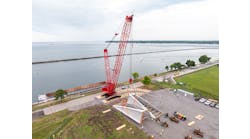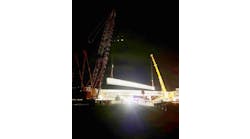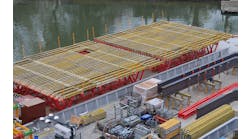By: Kelley C. Rehm, P.E.
With more than 600,000 bridges in the U.S., many of them closing in on or surpassing their original 50-year design lives, the need to ensure safety is at the forefront of concern in the bridge industry.
In the 2013 State of the Union address, the president noted the need for monitoring and repair of the nation’s 70,000 structurally deficient bridges. Also important for the nation’s bridges is the ability for owners to monitor bridge condition in order to apply timely preservation activities to keep “good bridges good” and prevent more bridges from being classified as deficient. Continuation of successful bridge-inspection programs throughout the U.S. is an important element of ensuring safe bridges and cost-effective decision making. The industry is making strides to move to an even more inclusive and descriptive inspection program.
The AASHTO Subcommittee on Bridges and Structures (SCOBS), working with the Federal Highway Administration (FHWA) and state and local bridge owners, is continuing efforts to help ensure safe bridges for the traveling public by advancing more inclusive ways to look at bridge health. In a recent March Strategic Planning Workshop, SCOBS members voted for extending service life of bridges and assessing bridge condition as their top two focus areas for the next five years. The importance of advancing bridge inspection falls squarely into these two areas. One way AASHTO SCOBS has already contributed to the bridge-inspection industry is in the area of element-level bridge inspection.
At the CoRe
For more than a decade, many states have already employed element-level inspection using the model of Commonly Recognized [CoRe] Elements for Bridge Inspection. CoRe was developed in the mid-1990s by the FHWA and SCOBS to define bridge elements. The CoRe elements guide provided a basis for data collection, performance measurement, resource allocation and management decisions based on conditions of individual bridge components.
Prior to the CoRe Elements, bridge managers used data based on the National Bridge Inventory (NBI) to help make decisions. The NBI contains only the overall bridge condition inventory data, and it is assumed that bridge program managers also will generate a bridge-inspection report containing additional data. Many states rely on the combination of NBI data and inspection reports to make decisions. The NBI is still being used successfully today; however, the system is not comprehensive enough to provide performance-based decision support that includes economic considerations. Among some of the issues with the Condition Rating inspection approach, which is used to rate important NBI items such as deck, superstructure, substructure and culverts, are the following:
- Each bridge was divided into only four major parts for condition assessment: superstructure, substructure, deck and culverts. This level of detail was not sufficient to identify appropriate repair strategies or to estimate costs;
- Each of the four major parts was rated on a 0-9 scale by severity of deterioration, without identifying the deterioration process at work or the extent of deterioration;
- The ratings include the assessment of multiple distress symptoms and are expected to describe the general condition of the bridge. Inspection staff must decide which distress is more representative of the general condition. It is often difficult to decide what the general condition is when a bridge has mainly localized problems; and
- An overall sufficiency rating based on NBI data was used as a performance measure at the federal level for funding allocation, but this measure emphasized large-scale functional and geometric characteristics of bridges, making it hard to use for maintenance decision-making.
A majority of all states had moved to collecting at least some element-level data based on the CoRe guide by the year 2000. The CoRe document did cover most bridge elements and states also added state-specific elements of importance as well. However, updates to the original 1995 document were needed. In 2010, the Guide Manual for Bridge Element Inspection was developed to improve on the CoRe publication. The development was led by Michael Johnson, offic chief, Specialty Investigation and Bridge Management, with Caltrans and the SCOBS Technical Committee on Bridge Management, Inspection and Rehabilitation (T18). Improvements were made to better capture the condition of the elements by reconfiguring the element language to utilize multiple distress paths within the defined condition states. The multipath distress language provides the means to incorporate possible defects within the overall condition assessment of the element. The overall condition of an element can be utilized in this aggregate form or broken down into specific defects present as desired by the agency for Bridge Management System (BMS) use. The Guide Manual for Bridge Element Inspection provides a comprehensive set of bridge elements that is designed to be flexible in nature to satisfy the needs of all agencies. The complete set of elements capture the components necessary for an agency to manage all aspects of the bridge inventory utilizing a BMS.
The Guide Manual for Bridge Element Inspection breaks elements into three categories:
National Bridge Elements (NBEs)—These are the minimum element set to define safety and load capacity of bridges. They include decks, slabs, girders, columns, abutments, etc.;
Bridge Management Elements (BMEs)—These are the elements that define secondary bridge components such as protective coatings; and
Agency Developed Elements—The manual also supports the creation of agency-defined elements to ensure flexibility for the bridge owners.
The new manual is significantly different from the CoRe guide and will require an implementation phase by bridge owners. Implementation will include development of training, revisions to existing state manuals, data migration of elements from older forms of data collection, changes to software and training of bridge inspectors. There are many tools currently in use or under development which will help bridge owners with this implementation.
Software updates are already under way to help implementation. The AASHTOWare Bridge Management Software (BrM), formally known as Pontis 5.2, will be able to accommodate the new element definitions and will have the capability to handle subsets and agency-developed elements. Pontis also will facilitate the conversion of older element data. AASHTO also has sponsored freely available Migrator software to move agency data collected under the previous CoRe guide to the most recent specification. More information and the free download can be found at http://aashtowarebridge.com/download/. In addition, FHWA is developing a new translator software to allow element-level data collected under the AASHTO Element Level Guide Manual to be reported in the current NBI.
FHWA also has many efforts under way to work toward the implementation of these elements. They include incorporation of element-level bridge inspection information into the Bridge Inspector’s Reference Manual, the Safety Inspection of In-Service Bridges training course (FHWA-NHI-130055), and the Bridge Inspector Refresher training course (FHWA-NHI-130053/53A). Additionally, the FHWA Resource Center has developed a two-day Element Level Bridge Inspection training course. The two-day version of the course includes field exercises for two bridges including a bridge with a concrete superstructure and one with a steel superstructure. The expected course learning outcomes will be to explain terms such as the difference between an element inspection, component inspection and safety inspection, and clarify element environments, structure units, element condition states and element defect flags. The course also will explain the rules and conventions for identifying and quantifying elements; review as-built plans to identify bridge elements and appropriate units; interpret condition states based on visual observations; quantify and record visual observations; explain why bridge management is important; and explain how AASHTOWare Bridge Management Software—BrM—supports an agency’s business process.
Performance review
Although there was discussion in the early 1990s of making the CoRe Element Manual a national standard as part of the NBI, it was considered impractical at the time to modify the existing national standard. Instead, FHWA developed a translator algorithm to convert the new, more detailed CoRe element condition data into NBI condition ratings consistent with the old standard. This would allow states to perform inspections under the new standard while still reporting the results to FHWA under the old standard. This algorithm was completed and accepted by FHWA in 1997 and resulted in many states beginning the process of collecting element level data.
Over the last decade, however, it has become more and more apparent that funding decisions for bridge repair and maintenance need to be performance-based. Element-level inspection provides the means to help make better performance-based decisions for bridge management. FHWA has recognized the need to move to element-level reporting as well.
MAP-21 has recognized that states will need to not only collect, but also report to the federal government their element-level inspection data. In the National Bridge and Tunnel Inventory and Inspection Standards Program section of the MAP-21 bill, Section 1111, FHWA is directed to issue guidance and begin collecting element-level bridge inspection data on National Highway System bridges within two years of the enactment date. FHWA also is directed to study the cost-effectiveness, benefits and feasibility of collecting element-level data for non-NHS bridges. At this time, FHWA has issued a call for comments regarding this feasibility study. More information can be seen here: www.gpo.gov/fdsys/pkg/FR-2013-03-22/html/2013-06619.htm.
FHWA also is currently working on updates to the NBI Coding guide with regard to the elements. The updates will facilitate the transition from the current general component condition rating system to the AASHTO element-based reporting. The FHWA’s initial vision is to require reporting of element data for NHS bridges and accept data for all bridges. This is consistent with provisions in MAP-21.
Quoted as saying
As mentioned before, many states have been collecting element-level data for several years. States like Florida, Nevada and California have found benefits to collection of element-level data in decision making.
California is a key proponent of collecting element-level bridge inspection data and has put forth great effort in helping to develop the AASHTO inspection manual. Barton Newton, P.E., state bridge engineer with Caltrans, had the following to say:
Bridge-element inspection methods are now recognized as the new accepted national standard for the National Highway System by inclusion in the recently enacted “Moving Ahead for Progress in the 21st Century Act” (MAP-21). The AASHTO Guide Manual for Bridge Element Inspection along with the upcoming updates in the new edition results in improved, consistent and quantitative condition assessments that will allow local, state and federal agencies to more accurately report the condition of the bridge inventory in the United States. The goal of the manual is to capture the condition of bridges in a simple way that could be standardized across the nation while providing the flexibility to be adapted to both large and small agency settings. The impact of this improvement will be better decision-making, better tradeoff analysis and ultimately, a much [better] representation of the nation’s bridge needs.
Richard Kerr, P.E., Florida DOT bridge management inspection engineer, stated the following:
Florida has been inspecting bridges since 1998 with the Commonly Recognized Elements (CoRe) for bridge inspections. We have also added Florida-specific elements to handle our movable bridges and ancillary structures. Florida also uses element-level inspection for high-mast light poles, overhead sign structures and traffic-signal mast arms. We have found element-level inspection beneficial, since it provides greater detail to assess the status of our bridges and enables analysis of the performance of various bridge components. The element inspection data also allows us to better develop our bridge preservation and bridge repair projects. Florida plans to transition to the new National Bridge Elements to meet the requirements of MAP-21 . . . Florida will have to plan our transition and train our inspectors in performing inspections with the new elements.
Nevada also collects element-level inspection data. David Severns, P.E., the assistant chief structure engineer for Nevada DOT, contributed the following:
Nevada has been conducting element-level bridge inspections since 1996. Unlike the older, condition-rating inspection approach, in which the inspector assigns a singular, numerical rating to represent the overall condition of a bridge element, the element-level inspection approach is quantity-based and allows the bridge owner to track deterioration of each bridge element over time. This is advantageous, in that, by better understanding the rate of deterioration, the bridge owner can thus make more intelligent and cost-effective decisions related to preserving their bridge assets. In order to maximize the safety and efficiency benefits inherent in the element-level approach, it is vital that bridge-program managers construct and follow an inspection process which meets their individual needs.”
Element addition
Over the past year, again with the help of Michael Johnson of Caltrans, FHWA and AASHTO SCOBS, T18, a new edition of the AASHTO Manual for Element Level Bridge Inspection has been developed. AASHTO has streamlined the element definitions and data-collection guidelines to incorporate suggestions from numerous departments of transportation. As part of the update, several additional elements were identified, largely associated with unusual or nonstandard construction materials increasingly found on new and rehabilitated structures. The defects for the elements were standardized by primary material types such as reinforced concrete. Elements that are subject to common defects such as scour or load-rating reductions are now consistently presented throughout the manual. A major effort was made to update and standardize the condition state language for each type of element defect, and specific defect identifiers were developed for cross-reference purposes. It is expected that the revised manual and element definitions, including the standard defects, will be incorporated into the future FHWA notice of proposed rulemaking requiring element-data collection for on-system structures as required by MAP-21.
A database was created to capture the element specifications, to generate the great majority of the updated manual content automatically and to support any future revisions that may be needed. A technical appendix provides real-world examples of element inspection for several element types using the specification. Formal acceptance of the new version is expected to occur at the AASHTO Bridges and Structures Subcommittee meeting in June 2013 in Portland, Ore. The AASHTO Manual first edition can be purchased online at: https://bookstore.transportation.org/. The new edition is expected to be available in early 2014.
It is clear that the future of bridge inspection includes element-level inspection. AASHTO is working with the states and FHWA to help provide the tools needed for that future. R&B
About The Author: Rehm is a program manager for bridges and structures for AASHTO.


